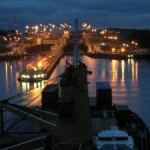(Montreal Gazette )It’s easy to brush off or ignore the federal government’s attempt to play up the virtues of its recently negotiated free-trade deal with Panama. The country has a GDP of $28.2-billion, which pales in comparison with Canada’s $1.5-trillion economy, and exports to Panama were a rather meagre $91-million last year.
)It’s easy to brush off or ignore the federal government’s attempt to play up the virtues of its recently negotiated free-trade deal with Panama. The country has a GDP of $28.2-billion, which pales in comparison with Canada’s $1.5-trillion economy, and exports to Panama were a rather meagre $91-million last year.
But rather than focus on the country’s size, focus on the crucial piece of infrastructure in that Central American country — the Panama Canal. Experts tout the supertankers coming from China that will have to pass through a bigger and refurbished canal set to open in 2014 to drop off goods to the U.S. ports on the Gulf and Atlantic coasts.
“The way Asian trade had been growing, and will resume growing once we get a recovery with momentum, is going to overwhelm existing Pacific ports. That’s why the Panama Canal activity is so important,” said Peter Hall, chief economist at Export Development Canada. “The very presence of that trade flowing through creates the need for logistics [and infrastructure] for the region.”
Panama is the key country in the trading bloc known as the Central American and Caribbean region, or CAC. This part of the world is small, but its economies are indeed growing, and are expected to advance at a slightly faster pace than many of the advanced economies in the years ahead.
There are advantages for Canadian companies in this region, as the countries are relatively easy to get to and they are in same time zone. And at least when it comes to most of the Caribbean, language is not a barrier as English is widely spoken or understood — leading some companies to eye the area as a possible location for call centres or other back-office operations. Canadian banks have invested heavily in the Caribbean, and mining companies are also active in the region.
In its recent global outlook, the International Monetary Fund envisaged 3.1% growth for Central America this year and 3.7% in 2011 (which is above the 2.2% average growth anticipated in 2011 from major advanced economies). For the Caribbean — which like Canada is tied to the ups and downs of the U.S. market — growth for the various countries is set to come in at 2.4% in 2010 but a stronger 4.3% in 2011.
Of course, there is a downside, as the IMF duly noted. “Central American and Caribbean regions, with their dependence on tourism and remittance flows from the United States, will be more vulnerable than others to weak U.S. economic conditions.”
The ties can’t be too close, though. For instance, the Dominican Republic posted growth of 3.5% in 2009, the same year advanced economies sank as a result of the recession. Economists at Scotia Capital expect the Spanishspeaking state to expand 4.3% on average this year and next.
“Domestic demand, the major growth driver, will continue to be propelled by investment spending while consumers’ prospects remain supported by better access to credit and a minor downtrend in unemployment,” Scotia Capital said in a report last month.
Experts say Canadian companies shouldn’t look to the CAC region for results now, but in the future — especially toward the middle of the decade, when the $5.3-billion expansion to the Panama Canal is set to be finished. Once completed, the revamped Panama Canal would be able to accommodate larger tankers, while the opening of a third set of locks would boost cargo flow by an estimated 35% through 2025.
It’s not as if Canadian investors have ignored the area. Exports to the CAC region grew on average by 10% per year from 2001 through 2008, when shipments topped $2.3 -billion. The bulk of exports are primary products, such as commodities, but high value-added products — such as medical equipment and engine turbines — make up 21% of the top 25 Canadian goods shipped to the region.
Mr. Hall said exports did take a sharp hit in 2009, but they appear to have benefited from the global rebound earlier this year, and are expected to do well as the world economy recovers.
Of course, increased Canadian involvement in the CAC would please the federal Conservative government. Since coming to power, it has pushed an aggressive trade agenda in the Americas. And at present, Canada is negotiating a trade agreement with the so-called Caribbean Community, or CARICOM.